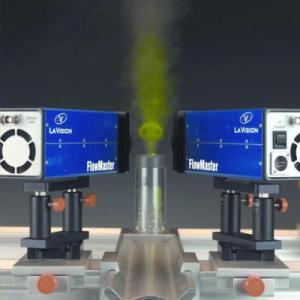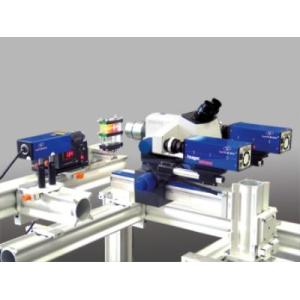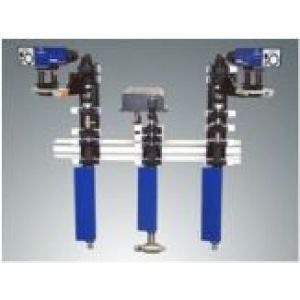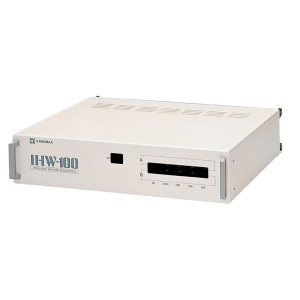测量效果: 平面(二位/三维)
产地类别: 进口
测量频率: 高频(100 HZ以上)
测速范围: 0-3km/s
测定准确度: 1%
测量区域大小: 1mx1m
看了粒子图像测速仪(PIV)的用户又看了
FlowMaster 3D直接由FlowMaster 2D的概念发展过来,可以测量在激光片光面内全部三个速度分量。
三维PIV基于立体成像原理:
两台相机从不同的角度拍摄被照亮的跟随流动的颗粒,Scheimpflug镜头布置可以使两个相机同时获得全场j聚焦良好的成像。一台相机,只能测量粒子位移在垂直于其光轴方向的投影,把两台相机拍摄到的投影图像组合起来,就能够再现被测流体中粒子的3分量立体位移。
用这样的方法,可以得到包含所有三个速度分量的完整向量。这种系统称为立体PIV,它是通过模仿人眼立体视觉原理而发展起来的。
自标定技术是目前在立体PIV系统中独特的专利技术,它可以修正标定靶和片光源之间的偏离,即使这个偏离很大也可以得到修正。目前在DaVis立体PIV软件包中它已经成为标准功能。利用自标定技术,通过计算粒子图像的偏移映射(地图)函数,所有测量面的位置以及片光厚度都可以获得。另外,偏移向量可以进一步修正非初始体映射函数引起的某些光学畸变。
采用自标定技术,标定靶盘甚至无需放置被测流场中。在很多内流模型中,例如生物医学研究的流动、微管道流动或者内燃机气缸内部流动等根本不可能放置标定靶的情况,利用自标定技术就可以完成其中的三维流场的测量。
FlowMaster Scheimpflug镜头布置
遥控调整
Scheimpflug 角度、
光圈及焦距
立体成像
自动标定矫正
图像畸变
最根本的解决方案:消除可能的标定误差
友好的用户界面:任意放置标定靶盘,无需使标定靶盘严格对准激光片光源
简便的扫描测量方式:所有扫描面的位置即刻获得标定结果
离线标定:可以使初始标定面在测量体以外
节省时间:标定准备可以离开测量现场进行
| 用户单位 | 采购时间 |
|---|---|
| 江苏大学 | 2015-11-02 |
| 上海交通大学 | 2012-11-01 |
| 清华大学 | 2004-11-01 |
| 北京大学 | 2009-09-01 |

德国LaVision PIV/PLIF粒子成像测速场仪
型号:FlowMaster® 150万 - 200万
显微粒子成像测速系统(Micro PIV)
型号:FlowMaster®-Micro 80万 - 100万
水下粒子成像测速系统(Under Water PIV)
型号:FlowMaster®-UW 200万 - 300万
热线风速仪CTA/HWA
型号:IHW-100 10万 - 30万DaVis是德国LaVsion公司推出的应用于反应和非反应流场测量,材料表面成像和追迹以及超快成像的智能(激光)成像技术的完整软件平台。 DaVis以灵活的图像采集模块,可用户定制的应用界面和特殊应用软件包三大特色功能成就了完美的成像系统所需软件。 DaVis软件可满足用户以纳秒量级的精度进行相机曝光,外部照明以及外部触发的同步控制并能自由选择采集图像序列。除此之外,DaVis软件拥有各种成像设置和控制的功能。 DaVis软件对用户开放,这种特色结合软件本身的宏命令语言,能够使得成像系统快速适应从高深的科学研究到可靠的工业应用等各种不同测量需求。 不仅如此,DaVis还拥有灵活的图像采集模式,先进的图像处理算法,多维图像数据的智能存储和显示,多种硬件的软件控制等功能。 集成了2DPIV和3DPIV功能模块的DaVis软件,参加了连续三年的PIVChallenge(http://www.pivchallenge.org)评测活动,均取得了优异成绩。客观证明了DaVis软件平台的出色性能。 PIVChallenge的组织者将两次PIVChallenge 活动的结果作了详尽的总结,并将结果发表在了公开的网站和杂志上。有关文章和下载网址如下: 1. Stanislas M, Okamoto K, Kaehler C (2003) Main results of the First International PIV Challenge. Meas Sci Technol 14:R63-R89 下载地址: http://stacks.iop.org/0957-0233/14/R63 或: http://www.oplanchina.com/download/Stanislas PIV challenge 2001.pdf 2. Stanislas M, Okamoto K, Kaehler C, Westerweel J (2005) Main results of the Second International PIV Challenge. Exp Fluids 39: 170-191 下载地址:http://www.oplanchina.com/download/PIV Challenge 2003 Results.pdf
LaVision GmbH粒子图像测速FlowMaster® 3D的工作原理介绍
粒子图像测速FlowMaster® 3D的使用方法?
LaVision GmbHFlowMaster® 3D多少钱一台?
粒子图像测速FlowMaster® 3D可以检测什么?
粒子图像测速FlowMaster® 3D使用的注意事项?
LaVision GmbHFlowMaster® 3D的说明书有吗?
LaVision GmbH粒子图像测速FlowMaster® 3D的操作规程有吗?
LaVision GmbH粒子图像测速FlowMaster® 3D报价含票含运吗?
LaVision GmbHFlowMaster® 3D有现货吗?
最多添加5台
